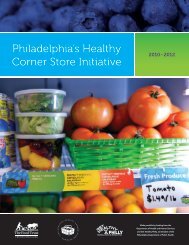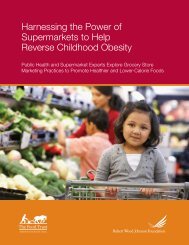The Grocery Gap: Who Has Access to Healthy - The Food Trust
The Grocery Gap: Who Has Access to Healthy - The Food Trust
The Grocery Gap: Who Has Access to Healthy - The Food Trust
You also want an ePaper? Increase the reach of your titles
YUMPU automatically turns print PDFs into web optimized ePapers that Google loves.
PolicyLink<strong>The</strong> <strong>Food</strong> <strong>Trust</strong>PrefaceFor decades, low-income communities of color havesuffered as grocery s<strong>to</strong>res and fresh, affordablefood disappeared from their neighborhoods.Advocates have long drawn attention <strong>to</strong> this criticalissue and crafted policy solutions, but access <strong>to</strong>healthy food is just now entering the national policydebate. While the problem is obvious <strong>to</strong> impactedcommunities, good policy must also be based onsolid data about the issue and its consequences.Unfortunately, it often takes years for the research<strong>to</strong> catch up with pressing needs in his<strong>to</strong>ricallyunderserved communities. Sometimes information isnot available. Other times, evidence is accumulatingbut it is buried in journals not widely read bypolicymakers. Or it is produced by practitioners andadvocates for local action campaigns and not acceptedby researchers or shared with policymakers or thebroader field. Too often, research focusing on lowincomepeople and communities of color, informedby their experiences, or conducted in partnershipwith them, is perceived as a political strategy,rather than as a legitimate search <strong>to</strong> understandproblems and inform strategies for change.PolicyLink and <strong>The</strong> <strong>Food</strong> <strong>Trust</strong> conducted thisinquiry <strong>to</strong> summarize the existing evidence base,carefully reviewing more than 132 studies. Wefound that a large and consistent body of evidencesupports what residents have long observed: manylow-income communities, communities of color,and sparsely populated rural areas do not havesufficient opportunities <strong>to</strong> buy healthy, affordablefood. <strong>The</strong> consequences are also clear: decreasedaccess <strong>to</strong> healthy food means people in low-incomecommunities suffer more from diet-related diseaseslike obesity and diabetes than those in higherincomeneighborhoods with easy access <strong>to</strong> healthyfood, particularly fresh fruits and vegetables.Centers for Disease Control and Prevention, adul<strong>to</strong>besity rates are 51 percent higher for AfricanAmericans than whites, and 21 percent higherfor Latinos. Black and Latino children are morelikely <strong>to</strong> become obese than white children. <strong>The</strong>lack of healthy food retail also hinders communityeconomic development in neighborhoods thatneed private investment, activity hubs, and jobs.Thankfully, the tide is beginning <strong>to</strong> turn. Researchersand policymakers are coming <strong>to</strong> consensus thatthis is a critical issue. And they are recognizing thatcommunities have developed innovative, sustainablesolutions that can work in other locales and at largerscales. In December 2009, 39 members of Congressfrom both political parties issued a resolution in theHouse of Representatives recognizing the need fornational policy <strong>to</strong> address limited access <strong>to</strong> healthyfood in underserved communities. <strong>The</strong> President’s2011 budget calls for more than $400 million <strong>to</strong>establish a national <strong>Healthy</strong> <strong>Food</strong> Financing Initiative,and this initiative is a key component of the FirstLady’s Let’s Move campaign <strong>to</strong> reduce childhoodobesity. Legislation <strong>to</strong> create a <strong>Healthy</strong> <strong>Food</strong>Financing Initiative is expected <strong>to</strong> be introduced inboth the House and the Senate in Spring 2010.This report presents powerful data. It confirmsthat as a nation we must answer the appeals ofcommunity activists seeking access <strong>to</strong> healthy foodfor their families and their neighborhoods. Wehope that it provides policymakers, advocates,philanthropists, and others with information,evidence, and analysis that can inform their efforts<strong>to</strong> eliminate “food deserts” from neighborhoodsand communities across the country.Inequitable access <strong>to</strong> healthy food is a majorcontribu<strong>to</strong>r <strong>to</strong> health disparities. According <strong>to</strong> theAngela Glover BlackwellFounder and CEOPolicyLinkYael LehmannExecutive Direc<strong>to</strong>r<strong>The</strong> <strong>Food</strong> <strong>Trust</strong>5






